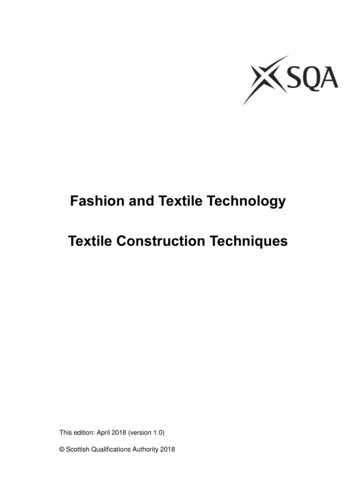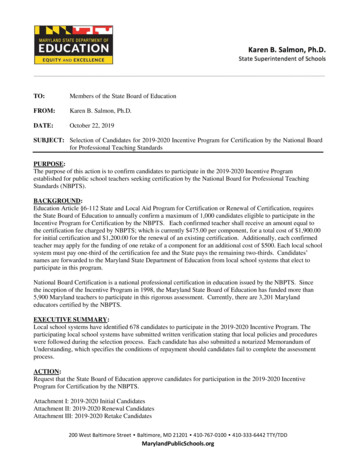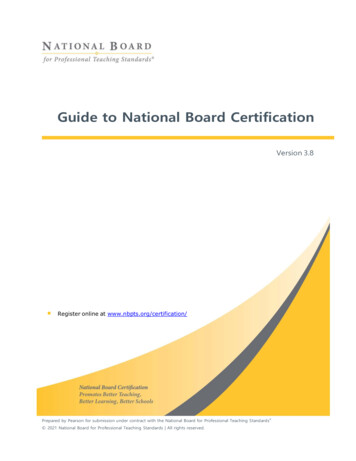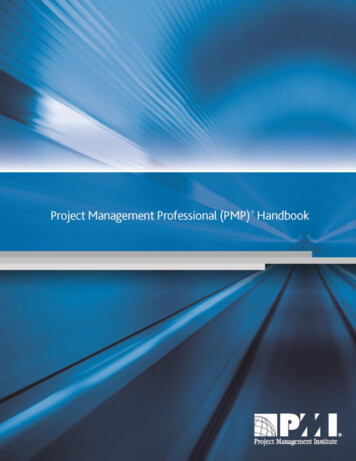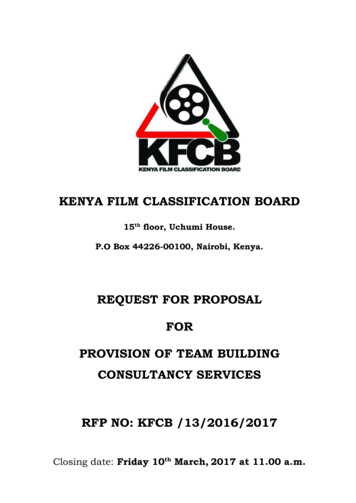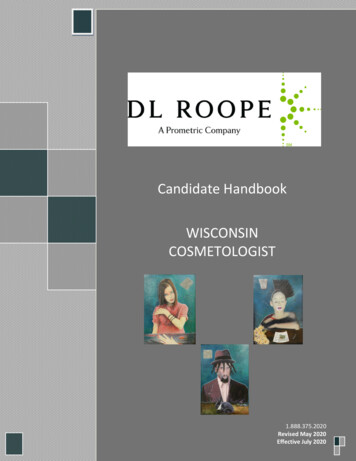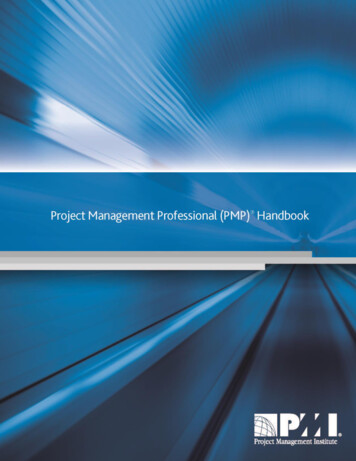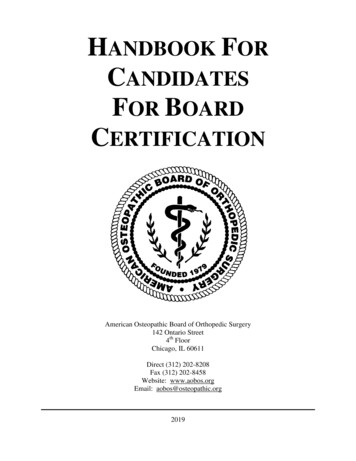
Transcription
HANDBOOK FORCANDIDATESFOR BOARDCERTIFICATIONAmerican Osteopathic Board of Orthopedic Surgery142 Ontario Street4th FloorChicago, IL 60611Direct (312) 202-8208Fax (312) 202-8458Website: www.aobos.orgEmail: aobos@osteopathic.org2019
American OsteopathicBoard of Orthopedic Surgery142 Ontario Street4th FloorChicago, IL 60611Direct (312) 202 -8105Fax (312) 202-8458Website: www.aobos.org E-mail: aobos@osteopathic.orgBoard MembersMarko F. Krpan, DO, ChairSeth D. Krum, DO, Vice ChairSean O’Brien, DO, Secretary-TreasurerNathan Melton, DOJohn Schlechter, DOThis edition of the Handbook for Candidates for Board Certification (circa 12/98) supersedes all previouspublications of this Handbook.Copyright 2019 by American Osteopathic Board of Orthopedic SurgeryAll rights reserved. No part of the Handbook for Candidates for Board Certification may bereproduced, stored, in a retrieval system, or transmitted in any form or by any means, electronic,mechanical, photocopying, recording, or otherwise without the prior written permission of thepublisher.Printed in the United States of America
TABLE OF CONTENTSPAGEIntroduction . 3Requirements for Board Certification. 4Appeal Policy . 6Board Eligibility . 7Termination of Board Eligibility . 8Re-entry in to the Certification Process . 9Application for Written Examination . 10Instructions for Written Examination . 11Application for Clinical Examination . 16Preparation of Logs for Clinical Examination . 17Subspecialty Orthopedic Surgeons . 20Sample Surgical Log . 23Hospital Location Sheet . 24Mortality Review . 25Clinical Examination Instructions Table of Contents . 26Change of Address Form . 4110/2019
INTRODUCTIONThe American Osteopathic Board of Orthopedic Surgery (AOBOS) recognizes that youare completing your training in Orthopedic Surgery. The information in the enclosedbooklet will assist you in proceeding through the Board certification process. Boardcertification in Orthopedic Surgery is administered by the American Osteopathic Board ofOrthopedic Surgery for the American Osteopathic Association (AOA). It requiressuccessful completion of a written examination, and a clinical review with oral defense.The clinical review with oral defense consists of a chart review, oral defense of cases, andobservation of surgical cases.Prior to May 16, 2018, the AOBOS certification process consisted of threeParts: the Part I Written, Part II Oral and Part III Clinical. The Part IIOral was given for the last time October 11, 2017. The AOBOS has revisedits certification process into a two part process consisting of the Part IWritten and Part II Clinical which includes and Oral Defense. The firstadministration of the new Part II Clinical will be the 2019/2020 wintercycle.The American Osteopathic Board of Orthopedic Surgery was established in 1979 andexists primarily for the purpose of assisting newly trained orthopedic surgeons in thecertification process. The purpose of the certification examination is to provide the publicwith a dependable mechanism to identify physicians who have met a standard to assureexcellence in the field of orthopedic surgery.Certification is valid for a ten-year period of time beginning with certificates issued on orafter January 1, 1994. You will be required to complete an OCC Cycle examinationevery ten (10) years thereafter. This OCC Cycle examination will be developed andadministered by the AOBOS.All the information necessary to complete the board certification process is included inthis handbook. Please read it carefully.pg. 3
REQUIREMENTS FORBOARD CERTIFICATIONAmericanOsteopathic Board ofOrthopedic SurgeryTo be eligible for certification in Orthopedic Surgery by the American Osteopathic Association(upon recommendation by the American Osteopathic Board of Orthopedic Surgery), the applicantmust meet the following minimum requirements: Be a graduate of an AOA accredited college of osteopathic medicine. Hold an unrestricted license to practice in the state or territory where his/her practice isconducted. An applicant for initial certification holding a restricted license maypetition the AOBOS for the ability to enter the certification process based upon reviewof the reason for licensure restriction. Be able to show evidence of conformity to the standards set in the Code of Ethics ofthe American Osteopathic Association. Five (5) years of AOA or ACGME approved training in orthopedic surgery arerequired. The applicant must provide documentary evidence that he/she has performed aminimum of 200 major orthopedic procedures of his/her own responsibility over aminimum period 12 consecutive months and at most 24 consecutive months. The applicant must practice within the specialty of orthopedics for a period of at least12 consecutive months subsequent to the required five years of approved training.Practice within orthopedics shall be defined as:The practice of osteopathic medicine and surgery in orthopedics, as defined in theBylaws of the Board, seventy-five percent (75%) of the time and submit anaffidavit attesting to the nature of his/her practice. Following satisfactory compliance with the prescribed requirements for theexamination, the applicant shall be required to pass the Written, and Clinical Exams toevaluate an understanding of the scientific basis of the problems involved in orthopedicsurgery; familiarity with the current advances in orthopedics; and possession of soundjudgment, and a high degree of skill in the diagnostic and therapeutic proceduresinvolved in the practice of orthopedic surgery.pg. 4
REQUIREMENTS FORBOARD CERTIFICATION continuedExamination shall be conducted and required as follows:1.Written examination may be taken upon completion of all requirements of theAmerican Osteopathic Academy of Orthopedics, AOA, or ACGME for anapproved training program in orthopedic surgery. This may be in the fifth year oftraining if the candidate is projected to be training complete at the end of the fifthyear.2.Clinical examination may be taken upon successful completion of the writtenexamination and after 12 consecutive months of orthopedic practice andsubmission of a log of all surgical procedures with a minimum of two hundred(200) major procedures from a single geographic location. The candidate’ssurgical log must span a minimum 12 months collection period and all majorcases within that timeframe must be included. If that amounts to more than 200cases, all cases must be included. If the candidate fails to reach 200 cases in 12months, collection may continue up to 24 months. The official date of certification shall be when the AOBOS notifies the candidate thathe/she has successfully passed all examinations and is being recommended to the AOAfor certification. Formal action by the Bureau of Osteopathic Specialists of the AOA isrequired to complete the process and the candidate may not claim certification untilnotified of this action in an official letter from the AOA. Certification is valid for a ten-year period of time beginning with certificates issued onor after January 1, 1994. You will be required to participate in all components ofOsteopathic Continuous Certification (OCC) to maintain your certification.pg. 5
APPEALPOLICYAmericanOsteopathic Board ofOrthopedic SurgeryThe American Osteopathic Board of Orthopedic Surgery (AOBOS) is committed toassuring that aggrieved candidates for certification have access to an appeal processconcerning the administration of any AOBOS examination.The AOBOS will allow a candidate to appeal an examination if the candidate feels theactions of the AOBOS, with regard to any part of the examination, constitute unequalapplication of the regulations and requirements or standards; unwarranted discrimination,prejudice or unfairness; or improper conduct of the examination.The AOBOS will not consider appeals based on the content of an examination, thesufficiency or accuracy of answers, scoring of the examination, scoring of answers toindividual questions, and/or the determination of the minimum passing score. However,to ensure that the computer generated scoring is accurate, ‘hand re-scoring’ is availablefor the review of recorded answers. There is a small supplemental fee for the hand rescoring option.Please note that limitations of your hospital’s Electronic Medical Record (EMR) systemare not a basis for appeal.The AOBOS has a formal appeal policy available on our website, www.aobos.org. Pleaseread the posted Appeals Policy for full details of the AOBOS appeal process.pg. 6
BOARDELIGIBILITYAmericanOsteopathic Board ofOrthopedic SurgeryBoard Eligibility is necessary to participate in the AOBOS certification process. Theonly exception is the Written Exam, when it is taken in the fifth year of OsteopathicOrthopedic Residency.Board Eligibility is automatic. Board Eligibility begins after the successful completion ofyour Osteopathic Orthopedic Residency and confirmation of ‘Training Complete’ statusby the American Osteopathic Academy of Orthopedics (AOAO).You shall be considered as board eligible for a period of six (6) years after the completionof your residency. Regardless of when you begin practicing, your board eligibility willexpire at the end of the sixth year following the completion of your residency program.For example, if the date you completed your residency was 6/30/2019, your boardeligibility would expire 12/31/2025.pg. 7
TERMINATION OFBOARD ELIGIBILITYAmericanOsteopathic Board ofOrthopedic SurgeryAll candidates initiating the certification process after July 1, 2009 (candidates not havingcompleted the Part I Written examination by 2009), must comply with the new Board Eligibilityand certification requirements listed below, as stated in the BOS Handbook:1. Board eligibility status will automatically be terminated and so recorded by the AOA andthe appropriate specialty certifying board:a. At the end of the board eligibility time frame, orb. Following resolution of an appeal, orc. Upon award of certification.2. In view of a candidate’s right to appeal the results of a failed examination, if boardeligibility would have terminated as a result of lapse of the six (6) year time frame, thedesignation of board eligible will not terminate until the appeal has been resolved.3. Candidates may not use the designation of board eligible at any time after the terminationof board eligibility.pg. 8
RE-ENTRY INTO THECERTIFICATIONPROCESSAmericanOsteopathic Board ofOrthopedic SurgeryFor candidates initiating the certification process after July 1, 2009 (candidates nothaving completed the Part I Written examination by 2009), the following reentry into thecertification process applies, as stated in the BOS Handbook:First Re-Entry Process1. Candidates must petition the specialty certifying board for entry into the certification process.2. Upon acceptance by the specialty certifying board, the candidate must follow the process below:a. The candidate must start at the beginning of the certification process. Prior activity towardcertification will not be recognized in the first re-entry process.b. Candidates must participate in the first available administration of the exam.c. The candidate will have two (2) attempts to pass each step of the examination process.d. If unsuccessful on a given administration, the candidate must participate in the next availableexamination administration.e. Candidates who were not successful in becoming certified at the end of the first re-entry pathwayprocess may pursue certification only by petitioning the certifying board for entry into the finalpathway process.Final Pathway1. Candidates must petition the specialty certifying board for entry into the final pathway process.2. The specialty certifying board is required to establish criteria that must be met prior to granting entryinto the final pathway process.a. These criteria must be approved by the Standards Review Committee (SRC) of the BOS.b. Upon notification of the criteria, the candidate must display efforts to conform and satisfy therequirements without delay.3. Upon completion of the requirements, the candidate must follow the pathway outlined below. Prioractivity toward certification will not be recognized in the final pathway process.a. Candidates must enter at the beginning of the board’s certification process.b. Candidates must participate in the first available administration of the exam.c. The candidate will have two (2) attempts to pass each step of the examination process.d. If unsuccessful on a given administration, the candidate must participate in the next availableexamination administration.4. Candidates who were not successful in becoming certified at the end of the final pathway have nofurther opportunity to become certified in the specialty or subspecialty.pg. 9
APPLICATION FORWRITTEN EXAMINATIONAmericanOsteopathic Board ofOrthopedicSurgeryApply online via the AOBOS website, www.aobos.org :This link will take you directly to the application page fm?board 118340Application Requirements: Examination fee of 1,650.00.The examination fee is Non-Refundable. No cancellations will be accepted once theapplication has been submitted.DEADLINE FOR APPLICATION IS JANUARY 15THNOTE: The exam will be administered by computer. Prometric , part of the ThomsonCorporation, provides scheduling and test centers for the exam. You will receiveadditional information regarding instructions on scheduling your exam appointment afteryour application has been accepted.pg. 10
INSTRUCTIONS FORWRITTEN EXAMINATIONAmericanOsteopathic Board ofOrthopedic SurgeryThe AOBOS administers the Written examination via Computer Based Testing (CBT), whichallows the candidate improved flexibility with test locations geographically closer to home.ANSWERS TO FREQUENTLY ASKED QUESTIONSHow much does the exam cost?The Part I Written examination fee is 1,650.When are candidates eligible to take the exam?Candidates are eligible as graduating 5th year residents or once in practice.What about candidates with disabilities?Candidates with documented disabilities must request specific accommodations 90 days prior tothe time of their application to take the exam. The AOBOS will work with the candidate toprovide accommodations that are appropriate to the disability. Prometric Testing Centers areall accessible to candidates in wheelchairs.May I cancel my application?Fees cannot be refunded after January 15th application deadline. The AOBOS will refund 90% ofthe application fee, if cancellation is received 30 days before the application deadline (byDecember 15th).How do I schedule an appointment to take the exam at a specific testing center?Following the acceptance of your application and after the application has closed you will receivean email with instructions on accessing your Prometric Scheduling Permit. You will receivethese instructions approximately 10 weeks before the exam date. Your Scheduling Permit willcontain instructions for scheduling your exam at a Prometric Testing Center . You shouldcontact Prometric as soon as you receive the permit. Prometric schedules on a first-come, firstserved basis. The sooner you schedule your appointment, the more likely you will receive yourpreferred location.pg. 11
INSTRUCTIONS FORWRITTEN EXAMINATIONcontinuedWhat does the exam entail? / What will the exam cover?The examination is a two hundred fifty (250) question multiple-choice examination.Where is the exam given?Computer-based delivery of the exam is provided by Prometric , a part of the ThomsonCorporation. There are more than 300 Prometric Testing Centers in North America at this time.The current testing center locations are available on the Prometric website at www.prometric.com .Will I be notified of the test center location and appointment time?When you contact Prometric to schedule your appointment, you will be required to provideinformation found only on your Scheduling Permit. Prometric will provide you with theconfirmed test day and time; the address and telephone number of the Prometric Test Centerwhere you will test; and your Prometric Confirmation Number.What are the testing centers like?Prometric testing centers typically consist of an office area with 7 to 15 computer testing stations.Prometric staff members will be on hand to check in candidates and supervise the testing session.When you arrive at the test center, your required identification will be checked, you will sign inon the test center log and your photograph will be taken. Also, all testing sessions are monitoredby video camera. Prometric administers a variety of educational, certification, and licensuretests; therefore, you may be at a testing center along with candidates taking other computer-basedtests.What do I need to be admitted to the test center?You should arrive at the Prometric Test Center 30 minutes before your scheduled testing time onthe exam date. If you arrive late, you may not be admitted. If you arrive more than 30 minutesafter your scheduled testing time, you will not be admitted. On arrival, you are required to signin on the test center log and to present your Scheduling Permit plus one form of unexpired,government-issued identification (such as driver’s license or passport) that includes both yourphotograph and signature, after which, a digital photograph will be taken. If it contains yourphotograph but not your signature, you can use another form of unexpired identification thatcontains your signature, such as an employee identification card or credit card, to supplementyour photo-bearing, government-issued identification. If you do not bring your SchedulingPermit and acceptable identification, you will not be admitted to the test.The first and last names on our identification MUST EXACTLY MATCH the names on yourpermit. The only acceptable difference would be the presence of a middle name, middle initial orsuffix on one document and its absence on the other. If your name is misspelled or differs fromyour name as it appears on your identification, contact the AOBOS immediately. Name changesor corrections cannot be made within 7 business days of the exam date.All of your personal belongings (including watches, cell phones, pagers and wallets), food andbeverages must be placed in a small, designated locker outside the testing room. Pagers and cellphones must be turned off before placing them in the locker.pg. 12
INSTRUCTIONS FORWRITTEN EXAMINATIONcontinuedHow long will a test session last and what does it include?The 6.5-hour test session includes:An optional on-line tutorial (1 to 30 minutes);An 84-item section (up to 110 minutes);An optional break (0 to 15 minutes);An 83-item section (up to 110 minutes);An optional break (0 to 15 minutes);An 83-item section (up to 110 minutes); andAn on-line post-test survey (no additional time scheduled).The maximum total testing time will be 330 minutes and the maximum total administrative timefor the tutorial, break, and survey will be 60 minutes.Time not used for the first 84-item section will NOT be available for the second 83-item section.Time not used for the first or second item sections will NOT be available for the third 83-itemsection. Time not used for the tutorial or break will NOT be available for answering items.Candidates will be free to leave as soon as they finish the test.Candidates will be allowed to leave the test center during the test breaks and are not to discussany test items with other candidates. If candidates take any test breaks, they must return to theworkstation in about 10 minutes to ensure that they initiate the next section of the test before thetest clock starts running. Otherwise, they will have fewer than 110 minutes for the next section.Will there be a tutorial available before the test administration date?Yes. A brief tutorial is available on the AOBOS website,http://orientation.nbme.org/Launch/AOBOS. All examinees will have the option to view thetutorial again at the test center at the beginning of the test session.What kind of computer skills will the exam require?The exam will use a simple, proven computer interface that will require only routine mouse, key,or cursor movements. Each item can be answered two ways:Move the mouse to the option bubble, left click the mouse, and depress the Enter key (orclick on the Next button at the bottom of the screen), orPress one of five letter keys (A, B, C, D, or E) and then depress the Enter key (or click on theNext button at the bottom of the screen).Please make sure that the bubble has been filled in before pressing Enter or clicking on the Nextkey. Otherwise, your response will not be recorded.If you accidentally proceed too quickly to the next item, it will be easy to return to the previousitem to review, mark for review, or change your answer.pg. 13
INSTRUCTIONS FORWRITTEN EXAMINATIONcontinuedWill each candidate get a different length test?No. Each examination will include 250 items. Adaptive examinations can vary in length, but theAOBOS exam will use fixed-length forms and will not be adaptive.Does the computer-based format affect examinee performance?Studies have shown that a change from a paper and pencil test to a computer-administered testhas no significant effect on candidate performance and that most candidates prefer the computerversion. Any initial anxiety usually dissipates after answering the practice items in the tutorialsection http://orientation.nbme.org/Launch/AOBOS.Will the examination scores be reported on site?No. The examination will be scored after the administration date. Candidates should expect toreceive their scores approximately 8-10 weeks after taking the exam.How will scores be reported?Notification will come from the AOBOS. Scores will also be posted online through the sameportal used to apply for the exam.What will the passing score be?The AOBOS will determine the minimum passing score.pg. 14
INSTRUCTIONS FORWRITTEN EXAMINATIONcontinuedIrregular BehaviorIrregular behavior is defined by the Board as any behavior that undermines the application,assessment, or certification processes of the Board or that threatens the integrity of thecertification process. Anyone having information or evidence that suspected irregular behaviorhas occurred should submit a written, signed statement to the Board providing a detaileddescription of the incident and/or circumstances and copies of any supporting documentationand evidence. Insofar as possible, such reports will be handled confidentially; however, theBoard will not investigate and/or act on unsigned or verbal reports. Irregular behavior mayoccur prior to, during, and/or following examination application and administration. Suchbehavior may include, but is not limited to, the following: seeking and/or obtaining access to examination materials prior to the examination falsifying information on application or registration forms impersonating a candidate or engaging another individual to take the examination byproxy (copying, giving, or receiving unauthorized information or assistance of any kindduring the examination) copying answers from another candidate or allowing answers to be copied making notes of any kind during an examination except on the laminated note boardsprovided at the test center memorizing and reproducing test questions and/or copyrighted information altering or misrepresenting scores failure to adhere to Prometric Test Center regulations possessing unauthorized materials during an examination administration (e.g., watches,recording devices, photographic equipment, electronic paging devices, cellulartelephones, reference materials) other behavior that threatens the integrity of the exam causing a disturbance of any kind leaving the test center while the test section is open removing or attempting to remove erasable note board from the testing room tampering with the operation of the computer or attempting to use it for any functionother than taking the examinationLooking in the direction of the computer monitor of another candidate during the examinationmay be construed as evidence of copying or attempting to copy, and a report of such behaviormay result in a determination of irregular behavior.pg. 15
APPLICATION FORCLINICAL EXAMINATIONAmericanOsteopathic Board ofOrthopedic SurgeryThe Clinical Examination is conducted at your practice hospital(s) usually during a month betweenJune and September for summer cycle exams or between December and March for winter cycleexams. Specific time and place will be determined by you and the senior examiner.Apply online via the AOBOS website, www.aobos.orgThis link will take you directly to the application page fm?board 118340Supplemental Application Materials (can be submitted online through the application portal):1. Examination fee of 3,250.00. If not accepted for examination, the Board will return 90% of thefee.2. Surgical Case Log. Logs shall include all major cases performed for a minimum of (12) twelveconsecutive months since entering orthopedic practice. To be accepted, NO LESS THAN 200MAJOR CASES must be documented. All surgical logs are subject to audit.3. A completed Hospital Location Sheet.4. A copy of your unrestricted state license.5. Mortality Review Summary Report if applicable. See page 25 for instructions.6. Copy of Fellowship Certificate, if a fellowship was completed.7. Photo. This can be a simple selfie, it is merely to aid in the avoidance of examiner conflict ofinterest.Surgical Case logs must reflect cases performed by the applicant and are not first assists or the work productof any other person. Current practice is required to be greater than 75% orthopedic medicine and surgery.DEADLINES for application: Feb. 15th for summer cycle examsAug. 15th for winter cycle examspg. 16
PREPARATION OF LOGS:CLINICAL EXAMINATIONAmericanOsteopathic Board ofOrthopedic SurgeryPLEASE NOTE:Information in this handbook regarding the clinical exam is for the NEW clinical examformat. If you have successfully completed the Part II Oral exam, please see the Part IIIClinical Exam Handbook (Historical Format).I. SUBMISSION OF SURGICAL LOGSYou must count all patient contacts from the time you begin your log until the ending date prior tosubmission. A patient contact is any treatment provided in the Hospital, Out Patient SurgeryFacility, Office or any other institution. Any patient that falls into one of the listed categories mustbe recorded and documented in your surgical logs. Routine office visits and non-surgical patientconsults and treatments do not need to be recorded. ALL other patient contacts for major surgery,fall into one of the categories and therefore will be listed in your logs.Mortalities are to be listed both in the category of primary treatment and under Category I(Mortalities). Mortalities apply to deaths that occur within 30 days of the surgicalprocedure. All mortalities require a summary report to be personally authored by the candidateand be submitted as part of the documentation necessary for the Clinical Exam application. (SeeMortality Review on page 25.)The Surgical Log must cover a minimum of 12 consecutive months of orthopedic practice with aminimum of two hundred (200) major procedures from a single geographic location. This is aminimum number of cases and should be exceeded in all but rare instances. All major caseswithin that timeframe must be included. If that amounts to more than 200 cases, all cases mustbe included. If the candidate fails to reach 200 cases in 12 months, collection may continue upto 24 months.These should be the most recent months just prior to your application for the exam (endingwithin six months of the application deadline). The 200 case requirement must be from a singlegeographic location. Any variations to the single geographic location requirement must beformally requested and approved by the AOBOS Board. Locum Tenens positions qualify if thesurgical cases meet the single geographic location requirement.All cases must be recorded during the time period. It is not appropriate to omit or exclude fromthe count any MAJOR case during this time period.All surgical logs are subject to audit. If a candidate’s surgical log is selected for audit, theAOBOS will require the hospital(s) surgical record for the candidate’s recording periodbefore their surgical log will be approved.II. MAJOR VS. MINOR CASESThe AOBOS uses the criteria established in the RBRVS, Resource Based Relative Value Scale(the physician payment schedule for Medicare) for what constitutes major vs. minor cases. Usethe RBRVS (Resource Based Relative Value Scale) to look up the code in question. If it has a
Oct 11, 2017 · certification in Orthopedic Surgery is administered by the American Osteopathic Board of Orthopedic Surgery for the American Osteopathic Association (AOA). It requires successful completion of a written examination, and a clinical review with oral defense. The clinical review with oral defense consists of a chart re



